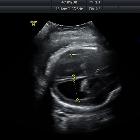fetal hydrocephalus





Fetal hydrocephalus often refers to an extension of fetal ventriculomegaly where the ventricular dilatation is more severe. It is usually defined when the fetal lateral ventricular diameter is greater than 15 mm .
Epidemiology
The estimated incidence is 0.5-3% per 1000 live births. There may be a very slight increased female predilection .
Pathology
It can be either obstructive or non-obstructive and each can arise from a number of etiologies. In a small proportion of cases, it carries a familial X-linked inheritance (congenital X linked hydrocephalus).
Causes
Associations
The vast majority of conditions are associated with other intracranial and cranial anomalies . The list includes:
- central nervous system anomalies: (more common and reported in more than 80% of cases)
- aqueductal stenosis: one of the commonest causative associations
- Chiari malformations
- neural tube defect(s)
- Dandy-Walker malformation
- encephalocoele
- alobar holoprosencephaly
- posterior fossa cysts
- polymicrogyria
- non-central nervous system anomalies
- craniofacial
- cleft lip +/- palate
- low set ears
- bilateral optic atrophy
- facial bone anomalies
- acrocephalosyndactylia
- congenital cardiovascular anomalies
- gastrointestinal anomalies
- genitourinary anomalies
- congenital renal fusion
- skeletal anomalies
- craniofacial
- syndromes
- chromosomal anomalies: may be present in ~20% of cases
See also: congenital syndromes associated with enlarged ventricles.
Radiographic features
Antenatal ultrasound
Will demonstrate enlarged ventricles with variable degrees of parenchymal thinning. The choroid may be seen floating within the ventricle giving a dangling choroid sign. Often a separation of more than 3 mm between the choroid plexus and the margin of the ventricle is considered abnormal. In some cases, there may also be evidence of macrocephaly.
Treatment and prognosis
The overall prognosis will depend on the underlying cause and associated anomalies. Some cases can slowly progress during the fetal period. Antenatal shunting has been considered in a small proportion of selected cases .
Siehe auch:
- Down-Syndrom
- Herzfehler
- Meckel-Syndrom
- Polymikrogyrie
- Klumpfuß
- fetal ventriculomegaly
- Aquäduktstenose
- Makrozephalie
- Dandy-Walker-Syndrom
- Lippen-Kiefer-Gaumen-Spalte
- Triploidie
- Meningoenzephalozele
- congenital syndromes associated with enlarged ventricles
- Chiari-Malformation
- in utero infection
- alobäre Holoprosencephalie
- low set ears
- Neuralrohrdefekt
- Miller-Dieker Syndrom
- pädiatrische Erkrankungen des Liquorsystems
und weiter:
- Spina bifida
- Pätau-Syndrom
- Myeloschisis
- fetal toxoplasmosis
- enlarged fetal ventricles
- Walker-Warburg-Syndrom
- fetal intra-cranial cystic lesions
- sonographic values in obstetrics and gynaecology
- differential diagnosis of intracranial cysts in the perinatal period
- Fryns-Syndrom
- Salonen-Herva-Norio syndrome
- fetale Hirntumoren
- kongenitale Aquäduktstenose
- hydrolethalus
- connatale Zytomegalie
- VACTERL-H association
- Zephalozele
- fetal X-linked hydrocephalus
- Mikrohydranenzephalie
- fetale Schizenzephalie
- Hydranenzephalie

 Assoziationen und Differentialdiagnosen zu kongenitaler Hydrozephalus:
Assoziationen und Differentialdiagnosen zu kongenitaler Hydrozephalus:















